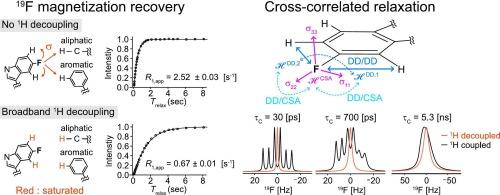评价1H解耦对5-氟色氨酸19F纵向弛豫和信号线形状的影响
IF 1.9
3区 化学
Q3 BIOCHEMICAL RESEARCH METHODS
引用次数: 0
摘要
芳香环中的氟19 (19F)是研究生物分子和小分子配体的结构、动力学和分子间相互作用的有用自旋探针。尽管涉及芳香19F探针的19F核磁共振有许多应用,但由于1H-19F自旋相互作用网络的复杂性,这些探针的定量松弛分析仍然具有挑战性。在本研究中,我们研究了5-氟色氨酸体系中1H-19F自旋相互作用,重点研究了1H解耦对19F弛豫性质和线形的影响。我们证明,1H解耦显著减缓了19F磁化恢复过程,导致敏感性降低,特别是在大蛋白质中。此外,1H去耦有效地消除了19F化学位移各向异性与1H-19F偶极子-偶极子相互作用之间的相互关联,解决了芳香19F信号的不对称线形。通过对h耦合的19F自旋系统的实验和理论分析,我们提出了一个解释这些弛豫行为的模型。我们的结果为优化芳香19F探针的1H解耦方案提供了实用指南,从而扩大了19F NMR的实用性。本文章由计算机程序翻译,如有差异,请以英文原文为准。

Evaluating the effect of 1H decoupling on 19F longitudinal relaxation and signal line shape in 5-Fluorotryptophan
Fluorine 19 (19F) in aromatic rings serves as a useful spin probe for studying the structure, dynamics, and intermolecular interactions of biomolecules and small-molecule ligands. Although 19F NMR involving aromatic 19F probes has a number of applications, quantitative relaxation analyses of these probes remain challenging due to the complexity of 1H-19F spin interaction networks. In this study, we investigated 1H-19F spin interactions in the 5-fluorotryptophan system, focusing on the effects of 1H decoupling on 19F relaxation properties and line shape. We demonstrate that 1H decoupling significantly slows down the 19F magnetization recovery process, leading to reduced sensitivity particularly in large proteins. In addition, 1H decoupling effectively eliminates cross-correlations between 19F chemical shift anisotropy and 1H-19F dipole-dipole interactions, resolving the asymmetric line shape of the aromatic 19F signal. Through experimental and theoretical analyses of the 1H-coupled 19F spin system, we propose a model that explains these relaxation behaviors. Our results offer practical guidelines for optimizing 1H decoupling schemes in aromatic 19F probes, thereby expanding the utility of 19F NMR.
求助全文
通过发布文献求助,成功后即可免费获取论文全文。
去求助
来源期刊
CiteScore
3.80
自引率
13.60%
发文量
150
审稿时长
69 days
期刊介绍:
The Journal of Magnetic Resonance presents original technical and scientific papers in all aspects of magnetic resonance, including nuclear magnetic resonance spectroscopy (NMR) of solids and liquids, electron spin/paramagnetic resonance (EPR), in vivo magnetic resonance imaging (MRI) and spectroscopy (MRS), nuclear quadrupole resonance (NQR) and magnetic resonance phenomena at nearly zero fields or in combination with optics. The Journal''s main aims include deepening the physical principles underlying all these spectroscopies, publishing significant theoretical and experimental results leading to spectral and spatial progress in these areas, and opening new MR-based applications in chemistry, biology and medicine. The Journal also seeks descriptions of novel apparatuses, new experimental protocols, and new procedures of data analysis and interpretation - including computational and quantum-mechanical methods - capable of advancing MR spectroscopy and imaging.

 求助内容:
求助内容: 应助结果提醒方式:
应助结果提醒方式:


